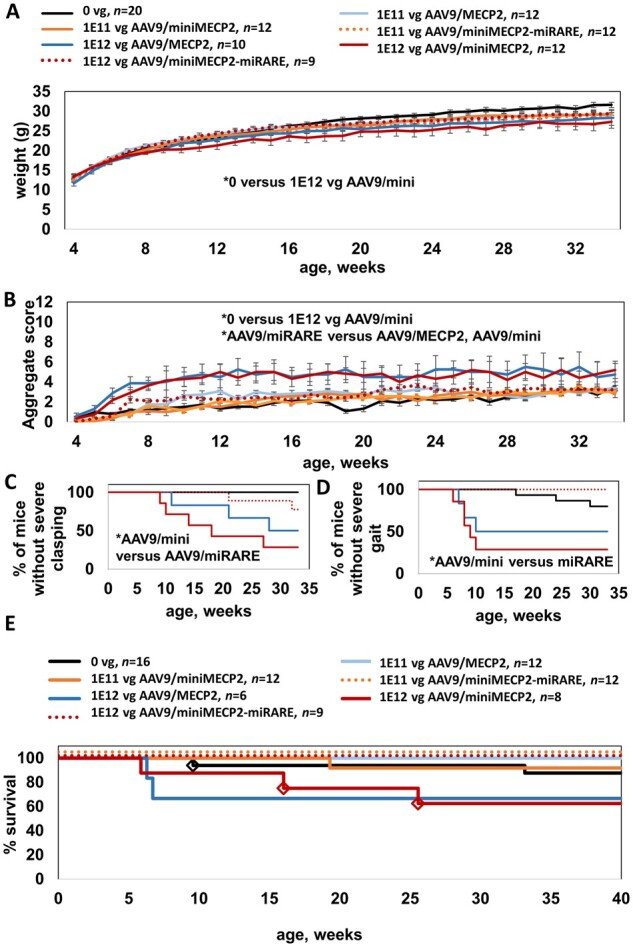Figure 5.

AAV9/miniMECP2-miRARE is well-tolerated after intrathecal administration in wild-type adolescents. Throughout this study, all treatments were administered between 4 and 5 weeks of age. (A) AAV9/miniMECP2-treated wild-type mice (1 × 1012 vg/mouse) had significantly lower weight than that of saline-treated wild-type mice beginning at 15 weeks of age (P < 0.05). No significant difference was observed between saline- and AAV9/miniMECP2-miRARE-treated wild-type mice (1 × 1012 vg/mouse). The same legend also applies to B. (B) AAV9/MECP2- and AAV9/miniMECP2-treated wild-type mice had a significantly higher mean aggregate behavioural severity score versus that observed for saline-treated mice (P < 0.05; at 6–30 and 7–27 weeks of age, respectively). AAV9/miniMECP2-miRARE-treated wild-type mice had a significantly lower mean aggregate severity score versus those of AAV9/MECP2- and AAV9/miniMECP2-treated mice at most time points from 11–19 and 9–20 weeks of age, respectively. No significant difference was observed between saline- and AAV9/miniMECP2-miRARE-treated wild-type mice (1 × 1012 vg/mouse). (C) Most wild-type mice treated with AAV9/miniMECP2-miRARE did not develop severe clasping abnormalities (severe clasping for n = 2/9 mice). (D) Wild-type mice treated with AAV9/miniMECP2-miRARE did not develop severe gait abnormalities (n = 0/9 mice). (C and D) Severe abnormal gait and severe clasping are each scored as a 2 on a scale of 0–2.33 All vectors were administered at 1 × 1012 vg/mouse. Mice that were euthanized early before developing severe gait or clasping scores (E) were excluded from data in C and D. (C and D) *P < 0.05 using Gehan–Breslow–Wilcoxon test, which can be used to evaluate significance for Kaplan–Meier plots. A one-way ANOVA of mean age of onset for D is not encouraged, as there are no time points listed here at which AAV9/miniMECP2-miRARE-treated wild-type mice develop severe gait abnormalities. (E) No early deaths have been observed for AAV9/miniMECP2-miRARE-treated wild-type mice. MiRARE groups are offset for clarity. Diamonds indicate veterinarian-requested euthanasias for bullying-related injuries (saline-treated) and for prolapses (AAV9/miniMECP2-treated). Prolapses were observed in 8–17% of AAV9/miniMECP2-treated wild-type mice (1 × 1011 to 1 × 1012 vg, respectively). Four AAV9/MECP2-treated mice were dissected at 8 weeks of age and were therefore excluded from the survival plot. The survival data for saline-treated wild-type mice also appears in Fig. 6D and Supplementary Fig. 9, as these mice were evaluated in parallel. (A and B) For simplicity only statistical differences between saline- and high-dose-treated wild-type mice were analysed. Data are means ± SEM. *P < 0.05.
